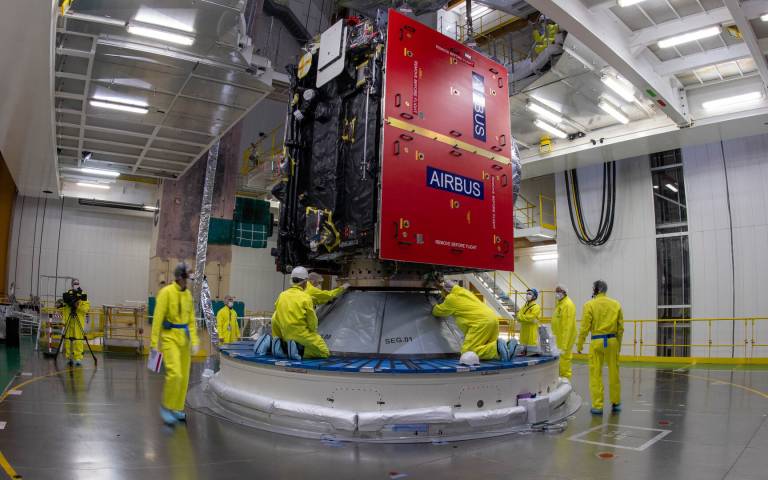A Jupiter-exploring mission, which includes hardware provided by UCL scientists, is due to take off tomorrow (Thursday 13 April)m and will investigate whether some of the planet's icy moons are home to conditions that could support life.

The European Space Agency's Jupiter Icy Moons Explorer (JUICE) will spend eight years travelling to the Jupiter system. On the way, it will perform fly-bys of Earth and Venus, using the gravitationalm fields of the planets to generate enough speed to reach Jupiter. One of these will be the first ever lunar-Earth gravity assist manoeuvre.
UCL researchers, funded by the UK Space Agency, provided particle detectors for the spacecraft's Particle Environment Package (PEP), which will sample the particles whizzing around Jupiter, including, potentially, from plumes of water spraying up from the moon Europa. UCL is also involved in the science teams for two other instruments: the J-MAG magnetometer instrument and JANUS optical camera system.
Professor Geraint Jones (Mullard Space Science Laboratory at UCL), a co-investigator on the PEP instrument and a member of the JANUS instrument team, who is coordinating plans for JANUS to study Jupiter's aurorae, said: "It's fantastic to see JUICE, carrying the PEP instrument that we contributed to, nearing its launch. We look forward to seeing data from our sensors on the 'soup' of ions, electrons and atoms surrounding Jupiter and its moons. This data will help us, for instance, to understand how particles around Jupiter reach such high energies - energies that could be fatal for an astronaut."
On arrival in 2031, JUICE will circle Jupiter and fly past moons Ganymede, Europa and Callisto, making observations and taking measurements, studying the Jovian system as an archetype for gas giants elsewhere in the universe.
Finally in December 2034, JUICE will transfer into orbit around Ganymede, becoming the first spacecraft ever to orbit a moon other than Earth's. While up close and personal with Ganymede, the mission will investigate the giant ocean that scientists believe hides under its icy crust, seeking evidence of habitability.
Professor Andrew Coates (Mullard Space Science Laboratory at UCL), a co-investigator on the PEP and JANUS instrument teams who in 2012 helped get the mission selected as a member of the ESA Science Definition Team, said: "I'm particularly looking forward to the PEP and JANUS data from [Jupiter's moons] Europa and Ganymede's weak watery atmospheres. We anticipate flying through potential plumes from Europa's subsurface ocean, and with PEP we hope to measure the particles at work in these interactions.
"If we find negative chlorine ions at any of the moons, as we have simulated, this would be direct evidence for subsurface salty oceans.
"Ganymede's 'magnetosphere within a magnetosphere' is also especially exciting and leads to interesting and unique effects like magnetic reconnection - the breaking and reconnecting of magnetic field lines - and the extremely powerful aurora we see at Jupiter's poles.
"Ganymede's unique magnetic field means that it has its own weak aurora too, as found by the Galileo mission. We look forward to flying through and exploring this more, amongst the many exciting science goals, like determining Ganymede's interior structure as JUICE orbits this intriguing moon from late 2034."
Professor Nick Achilleos (UCL Physics & Astronomy), a member of the science team for the J-MAG instrument, said: "One of the prime science goals for the J-MAG is to isolate, from the complex magnetic environment of Ganymede, the small magnetic signal corresponding to induced currents flowing in the subsurface ocean which is likely to be present. The variability and strength of this induced field signal will hold important clues as to the salinity, depth and thickness of Ganymede's ocean."






